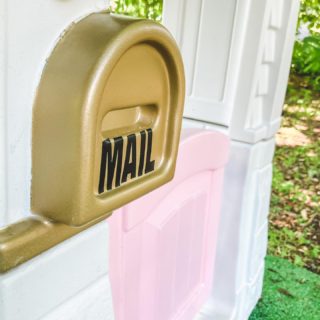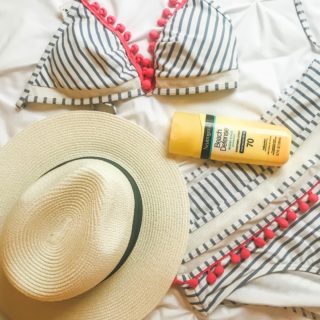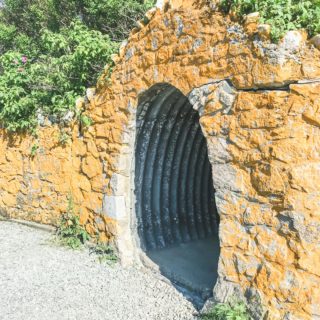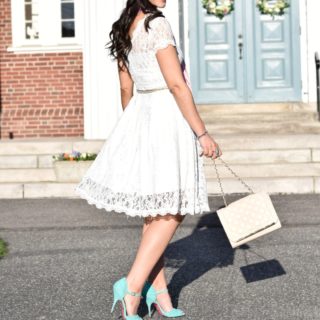Today I want to share with you the LAST STEP in our DIY Bathroom Refresher, how to install Peel-and-Stick vinyl floor planks. You can see Part 1 and Part 2 to have a better understanding of how we got here and what we were dealing with! Now, we had some ugly linoleum in the bathroom that clashed with pretty much everything in the room and installing these inexpensive peel and stick vinyl wood planks transformed the bathroom. The images speak for themselves!
These peel-and-stick planks are so great because they make for an easy install over linoleum because the base is already smooth.
————> Similar Peel-and-stick planks here <—————-
Materials I Used to Install Vinyl Planks
- Level – Mostly for measurements and having a straight edge to score the tiles. A yard stick would do too!
- Large Bowl / Sponge / Scrub Brush – For scrubbing the floors before install.
- Scissors – To cut the planks when it’s not a straight cut.
- Tape Measure – To measure length of gaps and boards.
- Pencil – To mark where to score on the vinyl planks.
- Utility Knife – To score the vinyl peel and stick flooring planks
- Contour Gauge – To make complicated cuts around door frames or toilet bowls easier.
- Style Selections Peel-and-Stick Vinyl Wood Planks in Golden Oak (This is no longer in stock at Lowes. Instead try THESE, which have similar price tags and similar reviews.)
- Caulk – to seal edges from moisture. I actually used a brown indoor/outdoor sealant to match my floors.
How to Install Adhesive Vinyl Floor Planks over Linoleum
1. First of all, I removed anything that was on the floor and vacuumed the bathroom. Make sure to get under any bathroom vanity or baseboard heater as you will need to apply adhesive tiles under those areas and you don’t want dust to get in the way of the tiles sticking properly.
2. If you have baseboards, remove them. As I don’t have any baseboards, I moved on to the next step.
3. Next I inspected the floors to see if there were any spots where the flooring was coming up. I used my utility knife to cut away loose edges (mostly in the corners where the linoleum was starting to come up). Ideally you would want to then fill in those gaps in the floor with leveling compound but since this is only to tide us over for a few years until we do a big bathroom remodel, I decided to just see how it worked without filling in the holes.
4. Clean the floor. I used dish soap, my scrub brush and sponge, the same as I used for Part 1 of this project. Then I let the floors dry 15 minutes.
5. To get started laying the vinyl planks, I measured the width of the bathroom with my tape measure at 3 points and marked the middle point with a sharpie. Then I drew a line down the middle, connecting each of the dots to make the first line I would use to lay down the tiles.
6. Use the directions on the box the planks came in to install the vinyl planks. In general, you remove the adhesive backing and press the tile onto the clean floor. (Some advise applying a floor adhesive first. I did not do this step and they still adhered fine but I would recommend this step if you want your floors to last longer than a few years.) I made sure to apply pressure with my knees and hands to the whole plank. Each plank has arrows on the back to show you the direction of the wood grain. Make sure each plank has the arrows going in the same direction.
The first plank is the easiest to install as you simply line the tile up on the line you drew and press it down firmly. I was lucky because my line matched up with the lines already on our linoleum flooring.
The next few planks are trickier. You want to push the end of next plank in to the end of the plank that is already adhered to the floor so that it makes a tight fit. Then, while it’s being pushed tight, flatten the rest of the board to the floor. Here is the part that took me a few tiles to learn:
To make the best fit, only push uncut ends up against each other. If you have to cut a board (which you will have to do), do not try to push the cut end up against an uncut end. No matter how hard you try, there will be a gap. Leave the cut ends for the outside walls.
Lay the vinyl planks uncut-end to uncut-end until you get to the end of a row where the gap is shorter than the plank.
7. Cut planks to fit the gap (more specifics below). There was a learning curve to this step as well. Overall you will mark your measurement on your board with your pencil. Then, use a straight edge (I used my level) to connect the two marks and score a straight line between them using your utility knife. Then, fold it in so that the plank snaps along the line that you scored.
But to ensure the best fit possible, you want the cut, uneven ends to be close to the wall where it will be covered with baseboard or filled with caulk. See below for more specific instructions.
8. Continue to install row after row of vinyl plank, staggering the planks so they are not the same size side by side, using your contour gauge to install around strangely shaped edges (more instructions below) until you have completed the entire floor.
9. Reinstall baseboards, or caulk the edges along the wall to seal the gaps and cover the uncut edges.
How to Cut Vinyl Planks So There Are No Gaps:
1. Measure the distance between the end of the last board you installed and where it will hit the wall or door jam. Make sure to leave a tiny bit of clearance at the end so that it fits into the space.
2. Lay the new full plank on the floor next to where it will be installed and make sure the arrows on the back are going in the same direction as the rest of the floor. Here’s where it gets tricky! Take the measurement you got of the gap and transfer it to the plank. CAUTION! Start measuring from the FLAT end of the plank to the side you won’t see. This makes it so you can connect two uncut ends and leave the cut end against the wall. (see below)
3. Take the cut plank that fits your gap and install it the same way you did with full planks, pushing the flat edge to the flat edge of the board already attached to the floor.
4. The rest of the board you will use for either the top or bottom of another line of planks because you need to keep it going the same direction and you don’t want to try to push a cut end to a flat end because it will leave a gap. (In my picture above, the rest of that board will become the BOTTOM of a new row since the cut end is at the bottom).
Sometimes it’s easy because you can start the next line of vinyl planks with your cut end. Other times it may end up being the same length as the one next to it and you may have to wait for another line of planks before you can use it.
How to Cut Vinyl Planks Around Odd Angles:
The process of laying the vinyl flooring goes very quickly until you get to something like a door frame or the base of a toilet (ideally you could remove a toilet but if you’re like us, your toilet simply won’t let you remove it…). This is where a contour gauge comes in very handy because it takes the shape of your object and lets you transfer that shape to your plank.
Press the contour gauge flat into the spot you want to capture. For planks, I lay my plank next to it so I can then measure the distance from the end of the contour gauge to the edge of the plank. Measure that distance directly on the plank and then place the contour gauge on the plank and trace the shape that you need to cut.
Cut the shape out with your scissors since it is not just a flat line you can “snap”. Check the fit. Sometimes you need to trim more off and check the fit a few times before it is the perfect fit and you can remove the backing and press the plank down onto the floor.
That’s it friends, how to apply Peel-and-Stick vinyl floor planks to transform your bathroom! I am very happy about how it turned out and my husband is too.
See Part 1 (painting ugly ceramic bathroom tile) and Part 2 (painting baseboard heaters and removing old wallpaper) of this series to see where we came from and how I transformed this bathroom. What do you think? Worth the time it took to transform it? Let me know in the comments below!
Thanks for stopping by!
~Virginia








 Loading...
Loading...



















Hi! just discovered your blog and will read more. I have typical sheet vinyl with the bumply surface, and I wonder whether tiles will stick to it because the surface is supposed to be smooth. I’m looking at tiles, not planks, although your floor looks so nice that I’ll look into those too. Do you think anything will work on my vinyl? Thank you.
Hi Chris, I’m so sorry that I didn’t get the alert about this comment before but I’m glad it got bumped up in the comments today! I applied mine over the typical sheet vinyl and the self-adhesive tiles stuck well. One thing I will say though is that you really have to seal around the edges. I used caulk all away around the outside and where I did that the tiles didn’t budge. However, there is part of my floor that is under the heating unit and so I wasn’t able to get under there with the caulk. Those floor tiles have slid apart so you see gaps. Some reviews I saw when I first installed said that you should apply regular vinyl adhesive underneath the adhesive tiles and I can see how that would have helped. I have some vinyl adhesive tape that I used to patch a section of floor in one of our rental units and I am going to try to put that under the planks that have slid apart and see if that helps.
That’s a long answer, but yes, I think you can apply self-adhesive tiles or planks over your sheet vinyl. They will work great for a small space like an RV. Just clean the vinyl floor under it really well, make sure you follow the directions on the box and let the planks sit for 24 hours in the place where you will install them so they can adjust to the temperature, and seal around the edge so they don’t move!
I hope it works out for you! I still love mine!
Ahh, thanks Virginia! I just made an offer on a house that’s been nicely remodeled, BUT the bedroom has dog-stinky carpet that I’ll remove and I don’t know how the subfloor looks. I hate W2W carpet and would remove it anyway because of deep dirt and my own dog. I’ll do either planks or bamboo. Something that floats.
Hi again Virginia,
I went to Lowes to look at the planking and found several reviewers saying theirs had warped and/or curled. I love how yours looks so reading the reviews was disappointing. How is yours holding up after two years? I’m doing an RV, so not much floor space or money involved, but it will be physically hard for me to do. What other flooring would work over vinyl?
My veterinary clinic installed similar vinyl plank floors in our main hall and both exam rooms. They get mopped several times a day and have had tons of foot traffic and have held up wonderfully! They were installed in 2010 and we have been so pleased with them! Hope this helps!
Yes it does help. Thanks Amy!
Amy, do you know whether they used industrial-strength planks made for commercial use?
hi! your floors look fantastic!!!
my husband I put peel and stick vinyl tiles in our bathroom last night but when we walk across the floor there is a crackling sound. did you experience any of this? hoping this is something normal that will go away. thank you!!!
Hi Mallen, thank you! They’re still going strong too. I don’t remember a crackling sound when we installed the tiles. Did you install them over another flooring?
We put this vinyl down in the majority of our house in 2004. Grandkids, dogs, cats, etc. and the vinyl has served very well! Only had to replace one plank in all these years. Wise choice for anyone that wants beauty and durability. You name it and it’s probably been spilled. Dogs have accidents. There are no stains or loose planks! Do yourself a favor and seriously consider this option.
Yes! I love ours! I had to add some sticky tape to one plank but other than that, it’s still going strong and looks great! Glad you had a good experience with it too!
Hi, I’m really interested in doing this in the kitchen of our apartment that we rent (which has terrible linoleum floors) but I’m concerned about the ability to remove them when we eventually move out of the apartment. Do you know if these remove easily without damaging the linoleum underneath them?
Hi Katie, sorry it has taken me so long to reply. I’m no longer actively updating my blog so I don’t always catch comments. If you’re still thinking of doing the kitchen…I do think they would remove easily enough. I don’t think they’d damage the linoleum but you may have quite a bit of adhesive still sticking that you’d have to find a way to remove without damaging the linoleum. I think I could do that easily enough on the linoleum we have but I can’t speak for yours! They stick pretty well but it would not be too hard to pull them back up again. If you used a blow dryer or something similar to loosen the adhesive that would probably help too.
This will help so much in my learning to use peel and stick. Thank you !!!